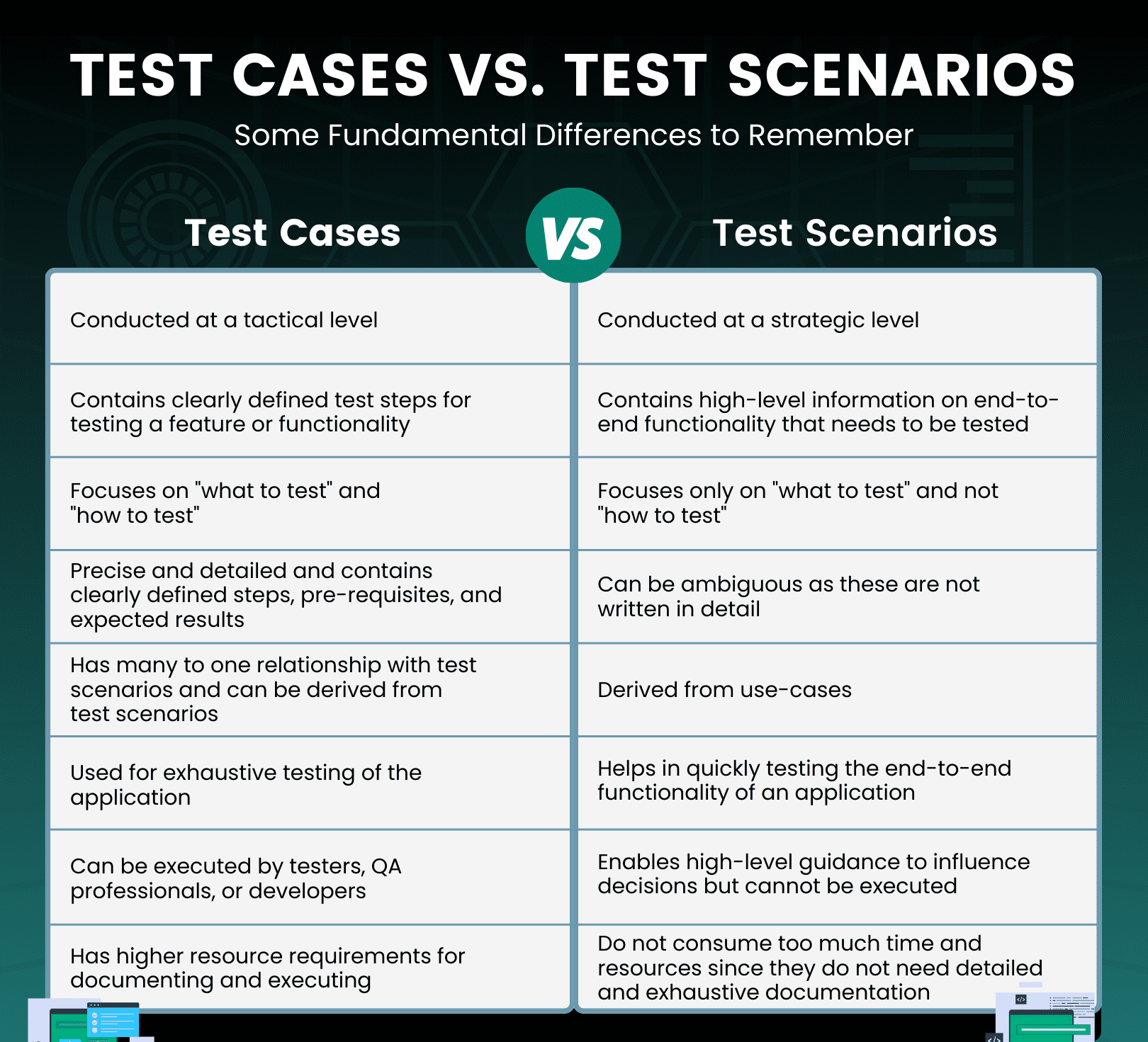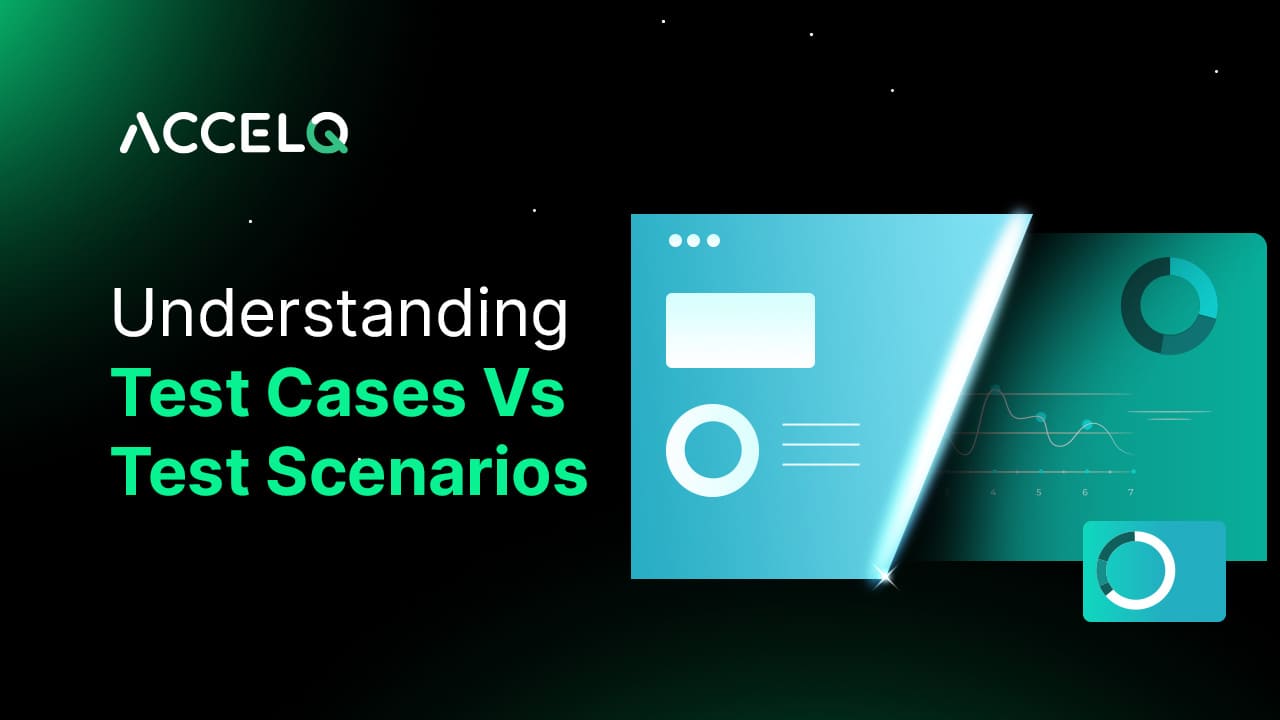Understanding Test Cases Vs Test Scenarios

Test cases and test scenarios are two of the most common test artifacts for comprehensive testing. Getting these two deliverables right is critical to product success as it allows software development teams and testers to work more efficiently. However, within QA testing, the difference between a test scenario and a test case can get lost in translation.
So, this article aims to provide a brief explanation of the fundamental differences between these two important testing deliverables. In that light, it covers the following:
Test Cases vs. Test Scenarios: Key Differences
Understanding the difference between the two becomes critical to perform testing more effectively and efficiently. Both test cases and test scenarios documents produced during the testing phase and offer stakeholders insights into testing progression . Let's take a granular look into what sets them apart.
A Case of Actionable Inputs vs. Real-World Requirements
A test case is a specific set of actions, instructions, or inputs employed to test particular functions or features of a software application. In concrete terms, it is a collection of conditions that testers use to determine application behavior and ascertain whether the feature or functionality behaves as expected.
Test cases emphasize actionable inputs, including positive, negative, and boundary values, to ensure exhaustive testing. As such, they contain details like steps to execute the test, test names, pre-and post-conditions of the tests, etc.
On the other hand, test scenarios are derived from use cases and account for the real-world scenarios where the software or application will be used. They provide a high-level overview of testing requirements and help categorize what's testable.
Writing test scenarios involves reading and addressing the software requirement documents and business function, system requirements, and functional requirement specifications. The test scenario must be related to the overall project in at least one significant way.
Ideally, a test scenario includes general descriptions of the steps that testers need to follow to test the function or feature. It defines the results that determine that an application works as expected.
Operational Validation vs. Functional Overview
Operational validation sits at the heart of test cases. To illustrate that, let's create a test case around the login functionality. If a tester has to validate the user login functionality, they have to stress the following steps and conditions:
- Are static and dynamic control and fields visible to the user?
- Define the steps to take to ensure the functionality’s working status
- Define the response of dynamic links, such as login buttons and hyperlinks to user interactions.
- Evaluate the UI communication with databases.
- Assess whether the basic flow is in place.
- Gauge mobile browser compatibility.
- Determine what happens when the user logs out or enters the wrong login credentials.
On the contrary, test scenarios provide a functional overview of a feature or module, offering a broad perspective on what requires testing.
For instance, testing the search functionality of an eCommerce site represents a test scenario. It offers a high-level perspective of what needs validation. This test scenario constitutes multiple sample test cases, each focusing on the operational validation of different search keywords and related functionalities.
Strategic Timing in SDLC:
Test cases are for testing specific features or functionalities. So, it's prudent to write them early in the SDLC, such as during the requirements gathering phase. They should contain all the requirements, use case documentation, and the overall test plan. At the end of the day, the essence of writing test cases lies in ensuring comprehensive and meticulous testing.
Likewise, it's important to write test scenarios early in the SDLC. These can effectively gauge the testing footprint and ensure that all features and functionalities are covered for testing. Based on these scenarios, test cases are then formulated.
The test scenarios' objective is to check the entire system performance from the end-user point of view, imitating users' behavior and assessing the scale of the work. These have to account for the actual scenarios the application will experience and operate under after release.

Writing Test Cases and Test Scenarios
As the spotlight on quality and user experience grows, creating strong test cases and test scenarios is more crucial than ever for software success. However, manually creating comprehensive test cases and then maintaining all the test cases and test scenarios can become challenging. This needs attention especially as the velocity of development increases and the need to test more, test fast, and test often rises.
As such, looking at a codeless test automation platform powered by the capabilities of AI becomes imperative. This is to lessen the burden on testers while ensuring that the testing footprint and test velocity remain uncompromised.
An AI-powered, no-code test automation platform like ACCELQ can help testing teams by:
- Offering a fluid test creation scenario designer – this simplifies and accelerates test case and scenario creation.
- Delivering AI-based test management with a holistic view of QA progress.
- Enabling automated test case generation for data-driven testing.
- Tracking test run configurations
- Delivering dynamic reporting capabilities with perspectives to easily slice & dice reports.
Connect with us to see how the ACCELQ platform can help your testing teams accelerate the testing velocity, expand the testing footprint, increase testing agility, and easily write robust, comprehensive, and detailed test cases and test scenarios.
Suma Ganji
Senior Content Writer
Expertly navigating technical and UX writing, she crafts captivating content that hits the mark every time. With a keen SEO understanding, her work consistently resonates with readers while securing prime online visibility. When the day's work ends, you'll find her immersed in literary escapades in her quaint book house.
Discover More
 No Code Vs Low Code Automation: Redefining Software Development
No Code Vs Low Code Automation: Redefining Software Development
No Code Vs Low Code Automation: Redefining Software Development
 Top 10 Test automation trends to look out for in 2024
Top 10 Test automation trends to look out for in 2024
































